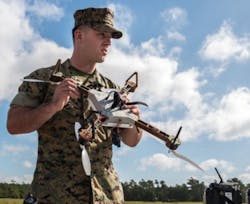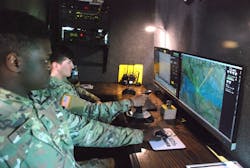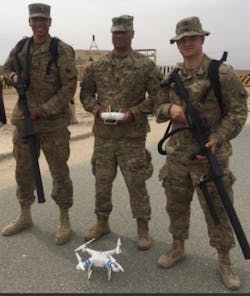Drones, Electronic Warfare, and Advanced Sensor Integration
Electronic warfare systems have become a vital aspect of modern combat, leveraged by another recent newcomer to the battlefield, advanced remotely-piloted vehicles and drones. RPVs and drones can employ a variety of electronic countermeasures, in addition to implementing their own jamming, intercept, and other SIGINT attacks.
Developing drones, RPVs, and other autonomous platforms presents a web of mission requirements, complicated by government-related compliance and regulatory issues. Federal procurement is heavily regulated, addressed mostly in United States Code Title 10, which outlines the role of armed forces, Title 31, on the role of the money and finance, Title 40, about the role of Public Buildings, Properties, and Public Works, and Title 41, on federal statutes regarding public contract.
The defense product life cycle is similar to, but different from, consumer-oriented products. Military procurement can involve weapons systems that will be deployed for decades, with a parts availability and product reliability that puts cars and trucks to shame. Maintenance also becomes more complicated, considering expected operational lifetime factors such as subsystem upgrades, while continuing to supply parts for older configurations.
Combat is its own application space, and every weapons system is a customized solution, operating in an IoT- and Cloud-enabled specialized environment. Big Data is also an aspect of the military space, with situational information expanded to include combat-oriented telemetry like radar and aerial surveillance. This can go beyond predictive maintenance of the platform. For example, it can include functionality like the detection and assessment of combat damage.
The Electronic Battlefield
The electronic battlefield is a reality that has been in existence since the radio was invented. The ability to use the RF spectrum for both passive and active military operations changed the face of warfare. There are many aspects to electronic warfare, or EW systems, and they revolve around basic military principles. One must be able to detect and track the movements of the enemy, target various objectives for a variety of attacks, and protect your forces from the enemy’s counter-efforts.
Developing Drone and RPV systems are extremely complex, especially in a government and military context, due to the complexity of the development stages, and systems integration complexity. Project management and technical challenges present themselves in terms of resource management, power management, security, communications, and other challenges related to testing, simulation, and regulatory compliance.
A typical platform consists of systems involving control, monitoring, and data processing, as well as the physical parts of the takeoff and landing system. Beyond creation issues, factors that affect the maintenance performed on RPV and drones include the repair of defects incorporated in the software during the development process, or because of changes in the agreed-upon requirements, or a desire to improve performance.
Tests must address the choreography of all these systems, power conversion, motion control, motor control, signal integrity, RF performance, and other functionality parameters. For example, an antenna mismatch in the RF stage not only wastes significant amounts of energy, but also creates thermal management issues, strains power management, and creates a potential for catastrophic failure. Optimizing each subsystem, conversely, creates cascading benefits, impacting vehicle range, battery size, and overall system reliability.
Electronic Warfare Considerations
There are also many things to consider when developing electronic warfare solutions to put into these platforms. Modern radio intercept involves real-time spectrum analysis, to see and evaluate everything that’s out there, with the ability to navigate complex and crowded RF environments. Modern countermeasures not only require agile RF systems, but also advanced software suites to perform the actual work involved.
Spectrum Monitoring over wide areas is one application for airborne RPVs and drones, as such activities used to require arrays of soldier-maintained antenna networks deployed across the battlefield. Such systems are also useful in applications like radio direction finding, providing map data for battlefield planners, in addition to direct data for counter-battery artillery and airstrikes, sometimes also performed by drones.
These platforms must not only determine spectrum occupancy, they must also perform signal classification and often threat determination, capturing transient comms for deeper analysis, replay, regeneration, recording RF signals of interest, and providing alarms and alerts on signal detection. This requires the ability to determine signal characteristics, frequency occupancy, modulation types, and other identifying aspects of the signal captured.
The U.S. military recently reinforced their commitment to open-systems standards for embedded computing and electronics design, as outlined in a memorandum by the secretaries of the U.S. Navy, Army, and Air Force. The memo mentions the Sensor Open Systems Architecture (SOSA), Future Airborne Capability Environment (FACE), Vehicular Integration for Command, Control, Communications, Computers, Intelligence, Surveillance, Reconnaissance, and electronic warfare interoperability (VICTORY), and the Open Mission Systems/Universal Command and Control Interface.
One of the biggest challenges in developing any advanced autonomous system involves sensor integration. Optical sensors can range from infrared to ultraviolet, and every wavelength in-between. Wireless systems must cover significant portions of the radio spectrum, in both active and passive modes, temperature, humidity, and pressure sensors provide environmental data, and proximity, angle, motor encoder, and wheel-position sensors deliver critical information to the vehicle itself for self-awareness, maintenance alerts, and navigation.
SOSA is a series of modular open systems architecture specifications for a variety of multiple-intelligence-based Command, Control, Communications, Computers, Intelligence, Surveillance, and Combat Systems Reconnaissance platforms that cross services and platform environments. The consortium provides a vendor-neutral forum for members to work together to harmonize, align, and create open standards to facilitate the development of agile, interoperable, and affordable sensors.
For example, the Air Force Research Laboratory’s AgilePod is a multi-intelligence reconfigurable platform that enables flight-line operators to customize sensor packages based on specific mission needs. While not a drone itself, the reconfigurable, open-architecture developmental platform is helping validate certain elements of the SOSA architecture and standards, for eventual integration into operationally fielded platforms.
Solutions for testing military and aerospace systems must determine the physical layer activity, electronic and RF, in the embedded systems involved. When it comes to testing anything wireless, it comes down to the ability to see what's going on in the RF domain in a live sense. For example, The right signal analyzers have real-time analysis capability that lets you see what your receiver sees.
When it comes to communications to drones, we’re looking at the nature and frequency occupancy and modulation characteristics of that RF interface. If we're looking at RF forensics, you need to be able to capture transient RF activity and rip that signal apart and look at the different aspects of that signal in the frequency domain, time domain, and modulation domain.
Spectrum interference is an issue, as platforms must share bandwidth between systems employing dynamic spectrum accessibility, as well as other non-authorized users’ encroachment within the operational system frequency. The congested spectrum requires quick identification of violations such as unauthorized transmissions, low probability of intercept (LPI) threats, or electromagnetic radiation hazards (RADHAZ).
Real-time spectrum analyzers, or RTSAs, have emerged as the go-to tool for tracking down elusive signals in a crowded spectrum. Once expensive and desk-bound, a new class of affordable, battery-powered, USB-based devices make an RTSA a powerful tool for interference-hunting applications. Drones and RPVs incorporate complex RF-control chips, and each device is a potential generator of more noise and interference. While it’s possible for design engineers to reduce the amount of noise by adding additional shielding and other noise-reducing features to products, it raises cost, weight, and solution size.
Noise and Interference
Another challenge to tackling these issues is that there is no perfect system for detecting noise. Trying to locate problems on the battlefield is especially difficult, compared to civilian environments, since there are so many electronic devices of varying types in use. Adding yet another layer of complexity, noise can change over time based on a wide variety of issues such as location or weather.
In today’s crowded spectrum, pretty much every frequency is being shared by some other person or service, which also impacts military systems. Adjacent channel interference can come from nearby tactical transmitters, or could be a result of enemy jamming and spoofing efforts. Impulse noise results from imperfect shielding in the device, allowing energy to leak out and interfere with RF devices. Noise can also result from a partial failure in a device or from other sources such as nearby electric motors, and other machinery such as generators.
Proper platform design must take in all of these noise issues, as they can directly impact both drone and RPV performance as well as the effectiveness of its onboard electronic warfare systems. Using a well thought out design, maximizing physical attributes of the platform and implementing solutions like TEMPEST, which stands for Telecommunications Electronics Materials Protected from Emanating Spurious Transmissions, will also help address noise in the system.
There are two sides to the RPV- and drone-detection coin; locating enemy drones, and preventing the enemy from finding yours. That there are enemy drones out there is a given, ditto the fact that the enemy is constantly trying to detect yours. The ability to develop battlefield situational awareness, deploy countermeasures, and engage the enemy is greatly enhanced if you know the enemy drone and/or the RPV’s controllers location.
Finding the Enemy
There are four main ways to monitor enemy RPV and drone activity. Radio frequency analyzers, acoustic and optical sensors, and radar are all used in this endeavor. RF Analyzers consist of one or more antennas to receive radio waves and a processor to analyze the RF spectrum. Some systems can identify the drone or RPV make and models, and some can even identify the MAC addresses of the drone and controller, if the drone uses Wi-Fi for communication.
Basic drone detection can be performed with the right spectrum analyzer and software. As drone operators generally use a first-person video link or other telemetry to track the drone’s location, the first step in looking for a drone’s presence is to scan the target spectrum to look for burst signals that are present as the drone and controller communicate to each other.
Drones and RPVs operate on frequencies including 900MHz, 1.3GHz, 2.4 GHz, and 5.8 GHz, with the majority of commercially-available UAVs operating in the 2.4GHz and 5.8GHz ranges. Some drones and RPVs use both at the same time to enable flight control and live video playback. Within the 2.4 GHz space, multiple drone operators could be flying at the same time. To uniquely control each drone, even when multiple drones coexist in the same airspace, requires complex signalizing that is only available from a few chip vendors. The waveform signatures used for this purpose are unique and can be identifiable.
Another aspect to consider is that drone control signals normally hop across multiple frequencies, and can be up to 80 MHz wide. With an 80 MHz wide detection capability, it’s possible to see the entire frequency hopping sequence to potentially determine the drone manufacturer or chip vendor, with greater accuracy, and take appropriate countermeasures.
Creating an automated drone detection system is simplified by networking multiple spectrum analyzers together with the proper software to perform fully-autonomous monitoring of the RF spectrum, to record unknown spectral events and generate alerts upon the discovery of unknown signals. To set up an automated drone detection system, nodes are set up around the outside perimeter, networked to a central operations center to provide comprehensive coverage of the perimeter. By utilizing multiple nodes, it’s possible to identify a drone’s location on the x-y-z axis.
Looking forward
Drones, RPVs, and other freely-roving platforms present a number of issues to the engineer, both on the development side for friendly forces, and on the detection and countermeasures side to address enemy systems. Selecting the best technologies, and the processes and methodologies to implement them, will go far to ensuring the success of your efforts.
About the Author
Alix Paultre
Editor-at-Large, Electronic Design
An Army veteran, Alix Paultre was a signals intelligence soldier on the East/West German border in the early ‘80s, and eventually wound up helping launch and run a publication on consumer electronics for the US military stationed in Europe. Alix first began in this industry in 1998 at Electronic Products magazine, and since then has worked for a variety of publications in the embedded electronic engineering space. Alix currently lives in Wiesbaden, Germany.
Also check out his YouTube watch-collecting channel, Talking Timepieces.




